
generative_ai_with_langchain
Build large language model (LLM) apps with Python, ChatGPT and other models. This is the companion repository for the book on generative AI with LangChain.
Stars: 568
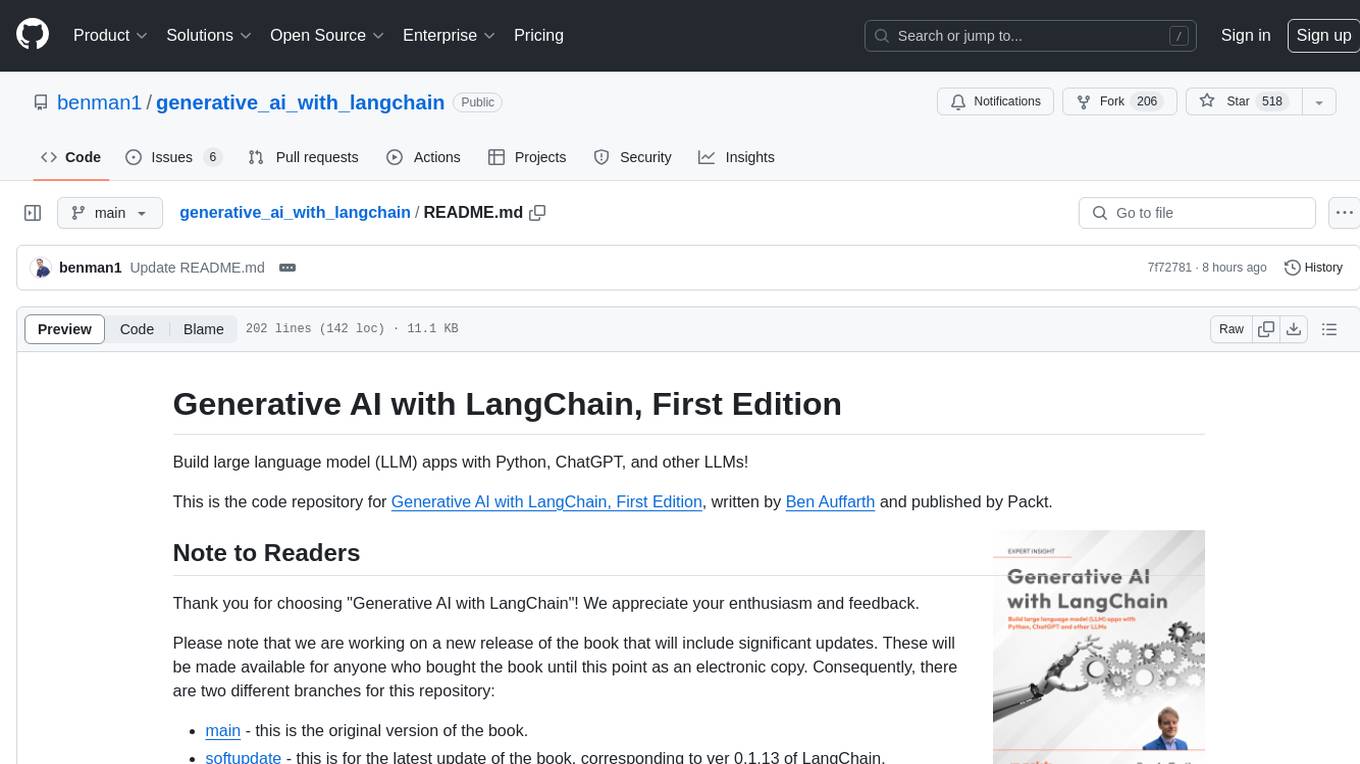
Generative AI with LangChain is a code repository for building large language model (LLM) apps with Python, ChatGPT, and other LLMs. The repository provides code examples, instructions, and configurations for creating generative AI applications using the LangChain framework. It covers topics such as setting up the development environment, installing dependencies with Conda or Pip, using Docker for environment setup, and setting API keys securely. The repository also emphasizes stability, code updates, and user engagement through issue reporting and feedback. It aims to empower users to leverage generative AI technologies for tasks like building chatbots, question-answering systems, software development aids, and data analysis applications.
README:
Build large language model (LLM) apps with Python, ChatGPT, and other LLMs!
This is the code repository for Generative AI with LangChain, First Edition, written by Ben Auffarth and published by Packt.

Thank you for choosing "Generative AI with LangChain"! We appreciate your enthusiasm and feedback.
Please note that we are working on a new release of the book that will include significant updates. These will be made available for anyone who bought the book until this point as an electronic copy. Consequently, there are two different branches for this repository:
- main - this is the original version of the book.
- softupdate - this is for the latest update of the book, corresponding to ver 0.1.13 of LangChain.
Please refer to the version that you are interested in or that corresponds to your version of the book.
If you have already purchased an up-to-date print or Kindle version of this book, you can get a DRM-free PDF version at no cost. Simply click on the link to claim your free PDF.
Free-Ebook
We also provide a PDF file that has color images of the screenshots/diagrams used in this book at GraphicBundle
Code Updates: Our commitment is to provide you with stable and valuable code examples. While LangChain is known for frequent updates, we understand the importance of aligning our code with the latest changes. The companion repository is regularly updated to harmonize with LangChain developments.
Expect Stability: For stability and usability, the repository might not match every minor LangChain update. We aim for consistency and reliability to ensure a seamless experience for our readers.
How to Reach Us: Encountering issues or have suggestions? Please don't hesitate to open an issue, and we'll promptly address it. Your feedback is invaluable, and we're here to support you in your journey with LangChain. Thank you for your understanding and happy coding!
You can get more engaged on the discord server for more latest updates and discussions in the community at Discord
This is the companion repository for the book. Here are a few instructions that help getting set up. Please also see chapter 3.
All chapters rely on Python.
| Chapter | Software required | Link to the software | Hardware specifications | OS required |
|---|---|---|---|---|
| All chapters | Python 3.11 | https://www.python.org/downloads/ | Should work on any recent computer | Windows, MacOS, Linux (any), macOS, Windows |
Please note that Python 3.12 might not work (see #11).
You can install your local environment with conda (recommended) or pip. The environment configurations for conda and pip are provided. Please note that if you choose pip as you installation tool, you might need additional tweaking.
If you have any problems with the environment, please raise an issue, where you show the error you got. If you feel confident, please go ahead and create a pull request.
For pip and poetry, make sure you install pandoc in your system. On MacOS use brew:
brew install pandocOn Ubuntu or Debian linux, use apt:
sudo apt-get install pandocOn Windows, you can use an installer.
This is the recommended method for installing dependencies. Please make sure you have anaconda installed.
First create the environment for the book that contains all the dependencies:
conda env create --file langchain_ai.yaml --forceThe conda environment is called langchain_ai. You can activate it as follows:
conda activate langchain_ai Pip is the default dependency management tool in Python. With pip, you should be able to install all the libraries from the requirements file:
pip install -r requirements.txtIf you are working with a slow internet connection, you might see a timeout with pip (this can also happen with conda and pip). As a workaround, you can increase the timeout setting like this:
export PIP_DEFAULT_TIMEOUT=100There's a docker file for the environment as well. It uses the docker environment and starts an ipython notebook. To use it, first build it, and then run it:
docker build -t langchain_ai .
docker run -d -p 8888:8888 langchain_aiYou should be able to find the notebook in your browser at http://localhost:8888.
Make sure you have poetry installed. On Linux and MacOS, you should be able to use the requirements file:
poetry install --no-rootThis should take the pyproject.toml file and install all dependencies.
Following best practices regarding safety, I am not committing my credentials to GitHub. You might see import statements mentioning a config.py file, which is not included in the repository. This module has a method set_environment() that sets all the keys as environment variables like this:
Example config.py:
import os
def set_environment():
os.environ['OPENAI_API_KEY']='your-api-key-here'Obviously, you'd put your API credentials here. Depending on the integration (Openai, Azure, etc) you need to add the corresponding API keys. The OpenAI API keys are the most often used across all the code.
You can find more details about API credentials and setup in chapter 3 of the book Generative AI with LangChain.
If you find anything amiss with the notebooks or dependencies, please feel free to create a pull request.
If you want to change the conda dependency specification (the yaml file), you can test it like this:
conda env create --file langchain_ai.yaml --forceYou can update the pip requirements like this:
pip freeze > requirements.txtPlease make sure that you keep these two ways of maintaining dependencies in sync.
Then make sure, you test the notebooks in the new environment to see that they run.
I've included a Makefile that includes instructions for validation with flake8, mypy, and other tools. I have run mypy like this:
make typecheckTo run the code validation in ruff, please run
ruff check .Create generative AI apps with LangChain.
ChatGPT and the GPT models by OpenAI have brought about a revolution not only in how we write and research but also in how we can process information. This book discusses the functioning, capabilities, and limitations of LLMs underlying chat systems, including ChatGPT and Bard. It also demonstrates, in a series of practical examples, how to use the LangChain framework to build production-ready and responsive LLM applications for tasks ranging from customer support to software development assistance and data analysis – illustrating the expansive utility of LLMs in real-world applications.
Unlock the full potential of LLMs within your projects as you navigate through guidance on fine-tuning, prompt engineering, and best practices for deployment and monitoring in production environments. Whether you're building creative writing tools, developing sophisticated chatbots, or crafting cutting-edge software development aids, this book will be your roadmap to mastering the transformative power of generative AI with confidence and creativity.
- Understand LLMs, their strengths and limitations
- Grasp generative AI fundamentals and industry trends
- Create LLM apps with LangChain like question-answering systems and chatbots
- Understand transformer models and attention mechanisms
- Automate data analysis and visualization using pandas and Python
- Grasp prompt engineering to improve performance
- Fine-tune LLMs and get to know the tools to unleash their power
- Deploy LLMs as a service with LangChain and apply evaluation strategies
- Privately interact with documents using open-source LLMs to prevent data leaks
This book is a comprehensive introduction to LLMs and LangChain, demystifying the basic mechanics of LangChain, its functionalities, and the myriad of applications it can be integrated into.
In the following table, you can find links to the files (directories) in this repository, and to notebook execution platforms such as Google Colab and Kaggle/Gradient Notebooks.
| Chapter | Files | Colab | Kaggle | Gradient |
|---|---|---|---|---|
| 01, What Is Generative AI | ||||
| 02, LangChain for LLM Apps | ||||
| 03, Getting Started with LangChain | ||||
| 04, Building Capable Assistants | ||||
| 05, Building a Chatbot like ChatGPT | ||||
| 06, Developing Software with Generative AI | ||||
| 07, LLMs for Data Science | ||||
| 08, Customizing LLMs and Their Output | ||||
| 09, Generative AI in Production | ||||
| 10, The Future of Generative Models |
If you feel this book is for you, get your copy today!
Ben Auffarth A seasoned data science leader with a background and Ph.D. in computational neuroscience. Ben has analyzed terabytes of data, simulated brain activity on supercomputers with up to 64k cores, designed and conducted wet lab experiments, built production systems processing underwriting applications, and trained neural networks on millions of documents. He’s the author of the books Machine Learning for Time Series and Artificial Intelligence with Python Cookbook. He now works in insurance at Hastings Direct.
For Tasks:
Click tags to check more tools for each tasksFor Jobs:
Alternative AI tools for generative_ai_with_langchain
Similar Open Source Tools

generative_ai_with_langchain
Generative AI with LangChain is a code repository for building large language model (LLM) apps with Python, ChatGPT, and other LLMs. The repository provides code examples, instructions, and configurations for creating generative AI applications using the LangChain framework. It covers topics such as setting up the development environment, installing dependencies with Conda or Pip, using Docker for environment setup, and setting API keys securely. The repository also emphasizes stability, code updates, and user engagement through issue reporting and feedback. It aims to empower users to leverage generative AI technologies for tasks like building chatbots, question-answering systems, software development aids, and data analysis applications.
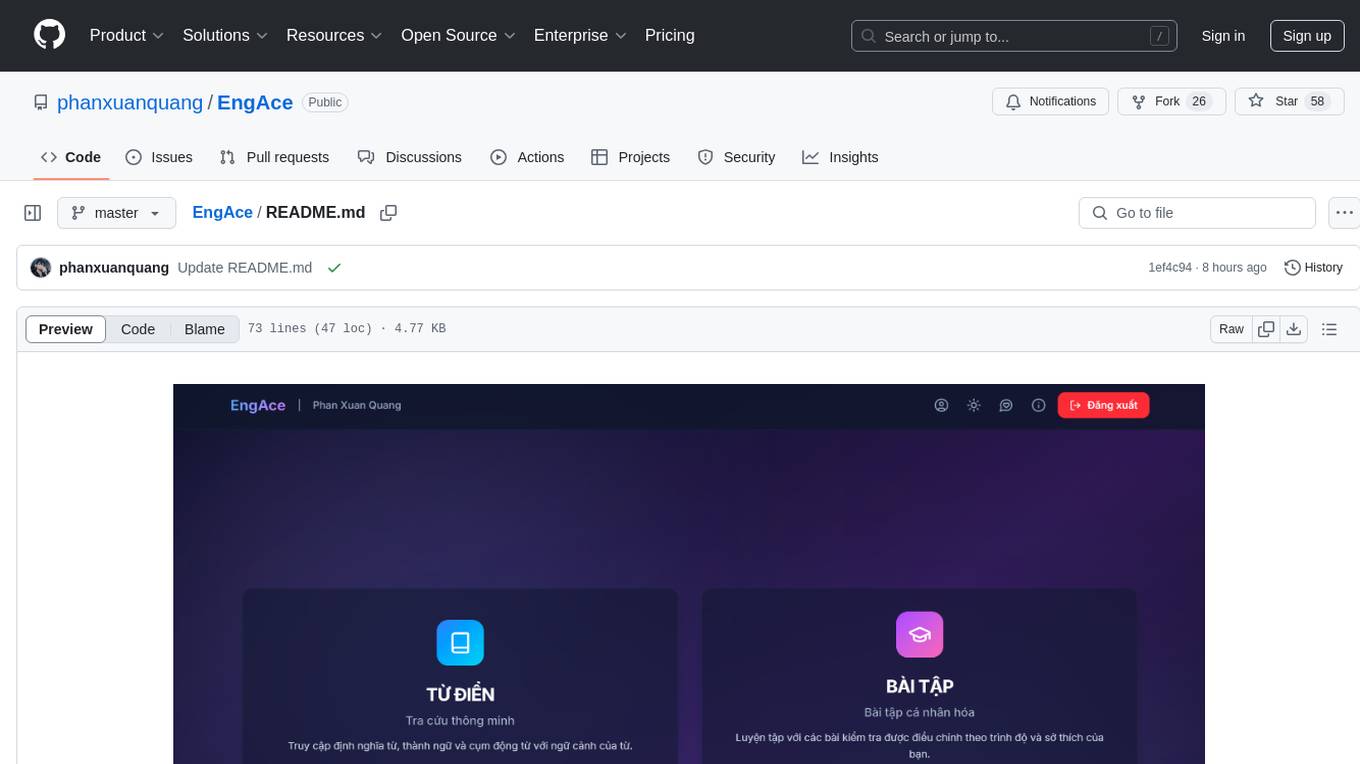
EngAce
EngAce is a cutting-edge, generative AI-powered application revolutionizing Vietnamese English learning. It offers personalized learning experiences combining AI with comprehensive features. The repository contains source code, documentation, and resources for the app.
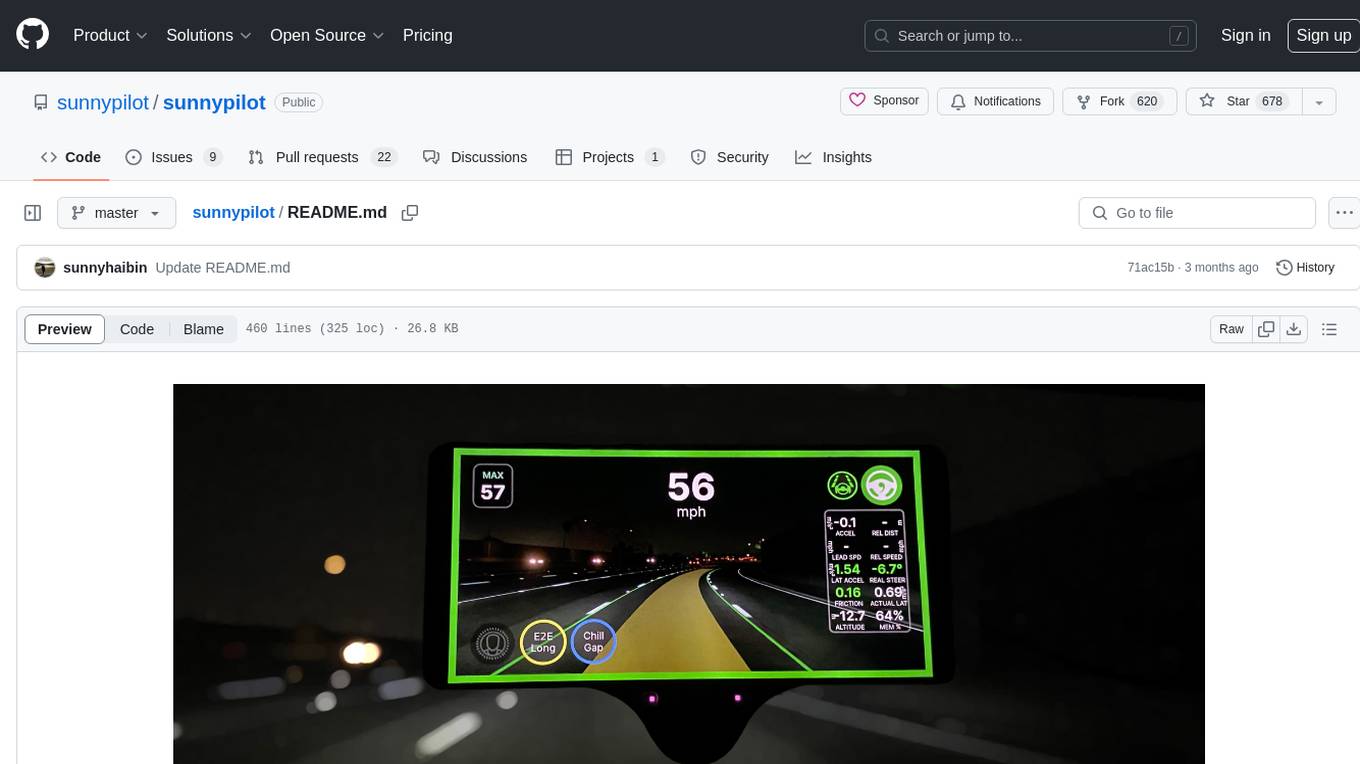
sunnypilot
Sunnypilot is a fork of comma.ai's openpilot, offering a unique driving experience for over 250+ supported car makes and models with modified behaviors of driving assist engagements. It complies with comma.ai's safety rules and provides features like Modified Assistive Driving Safety, Dynamic Lane Profile, Enhanced Speed Control, Gap Adjust Cruise, and more. Users can install it on supported devices and cars following detailed instructions, ensuring a safe and enhanced driving experience.

teams-ai
The Teams AI Library is a software development kit (SDK) that helps developers create bots that can interact with Teams and Microsoft 365 applications. It is built on top of the Bot Framework SDK and simplifies the process of developing bots that interact with Teams' artificial intelligence capabilities. The SDK is available for JavaScript/TypeScript, .NET, and Python.
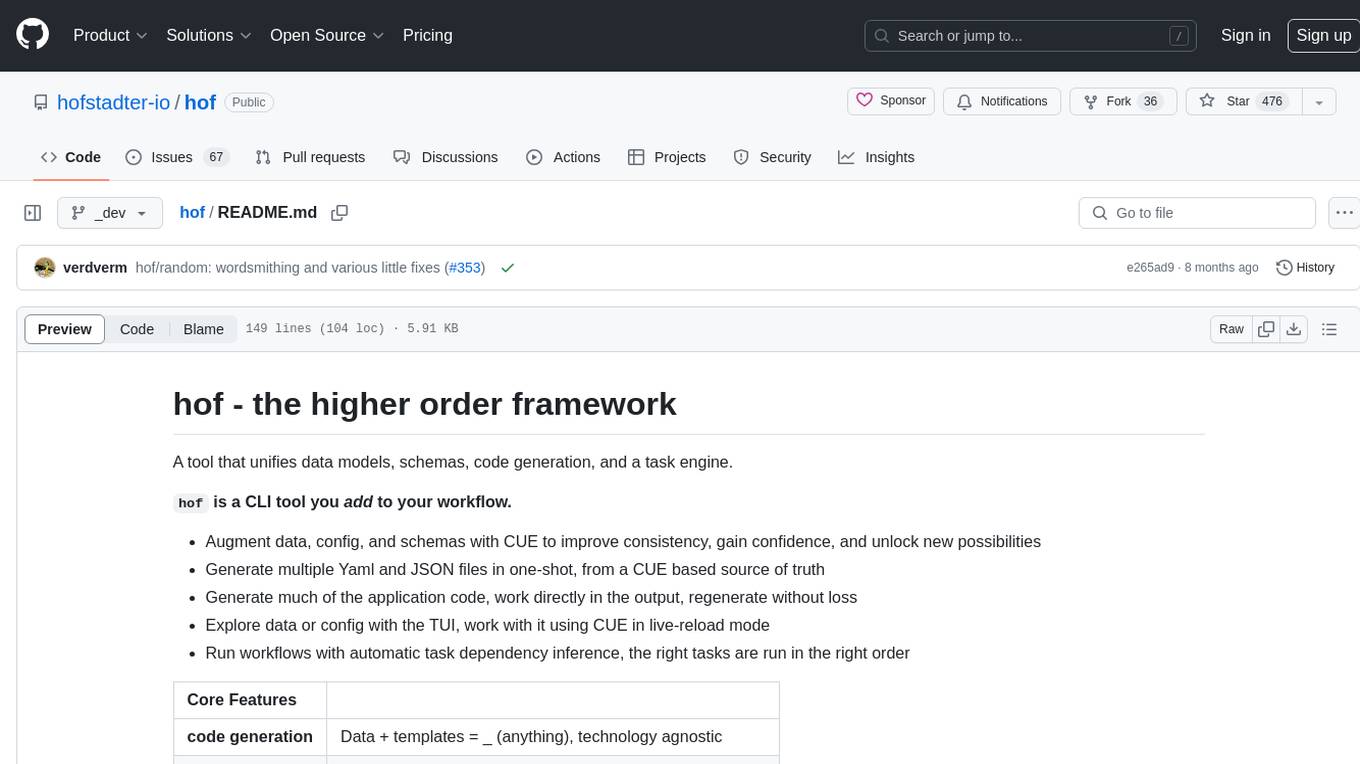
hof
Hof is a CLI tool that unifies data models, schemas, code generation, and a task engine. It allows users to augment data, config, and schemas with CUE to improve consistency, generate multiple Yaml and JSON files, explore data or config with a TUI, and run workflows with automatic task dependency inference. The tool uses CUE to power the DX and implementation, providing a language for specifying schemas, configuration, and writing declarative code. Hof offers core features like code generation, data model management, task engine, CUE cmds, creators, modules, TUI, and chat for better, scalable results.
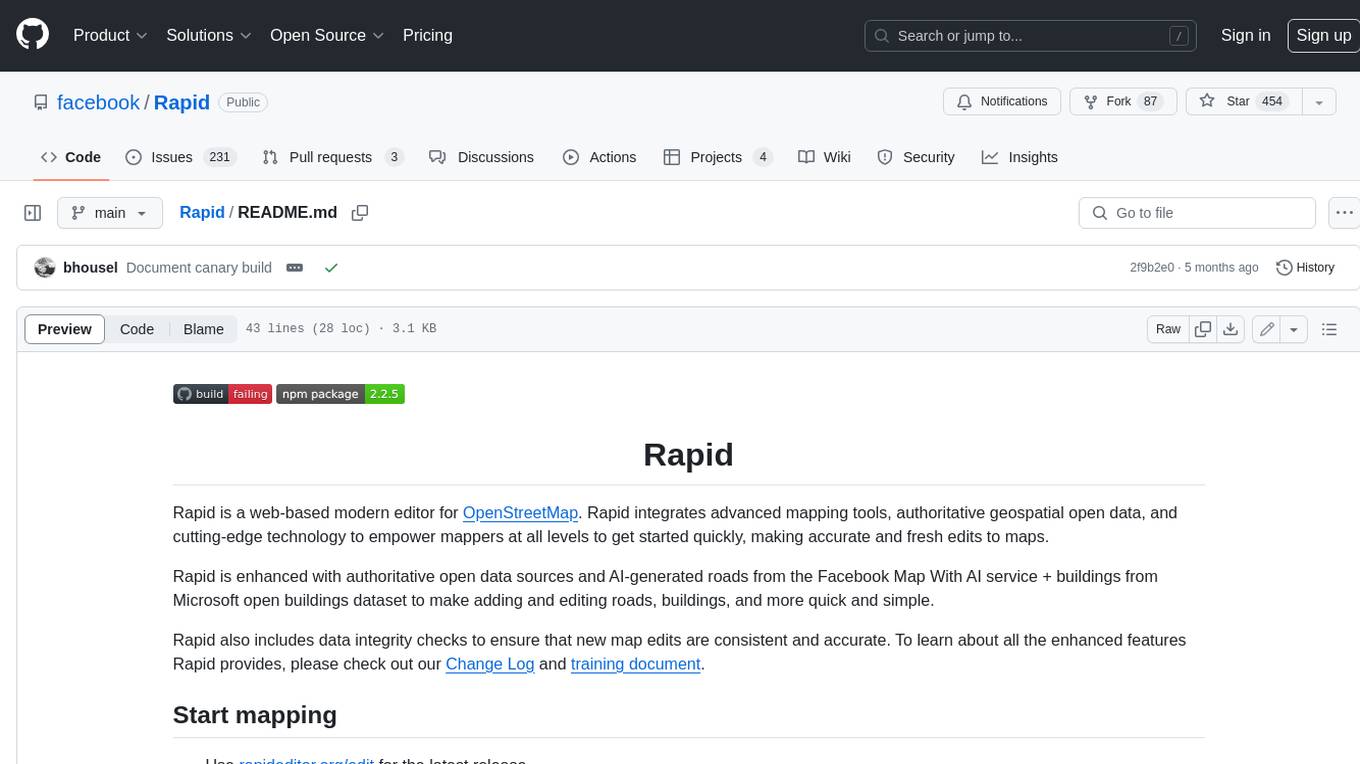
Rapid
Rapid is a web-based modern editor for OpenStreetMap. It integrates advanced mapping tools, authoritative geospatial open data, and cutting-edge technology to empower mappers at all levels to get started quickly, making accurate and fresh edits to maps. Rapid is enhanced with authoritative open data sources and AI-generated roads from the Facebook Map With AI service + buildings from Microsoft open buildings dataset to make adding and editing roads, buildings, and more quick and simple. Rapid also includes data integrity checks to ensure that new map edits are consistent and accurate.
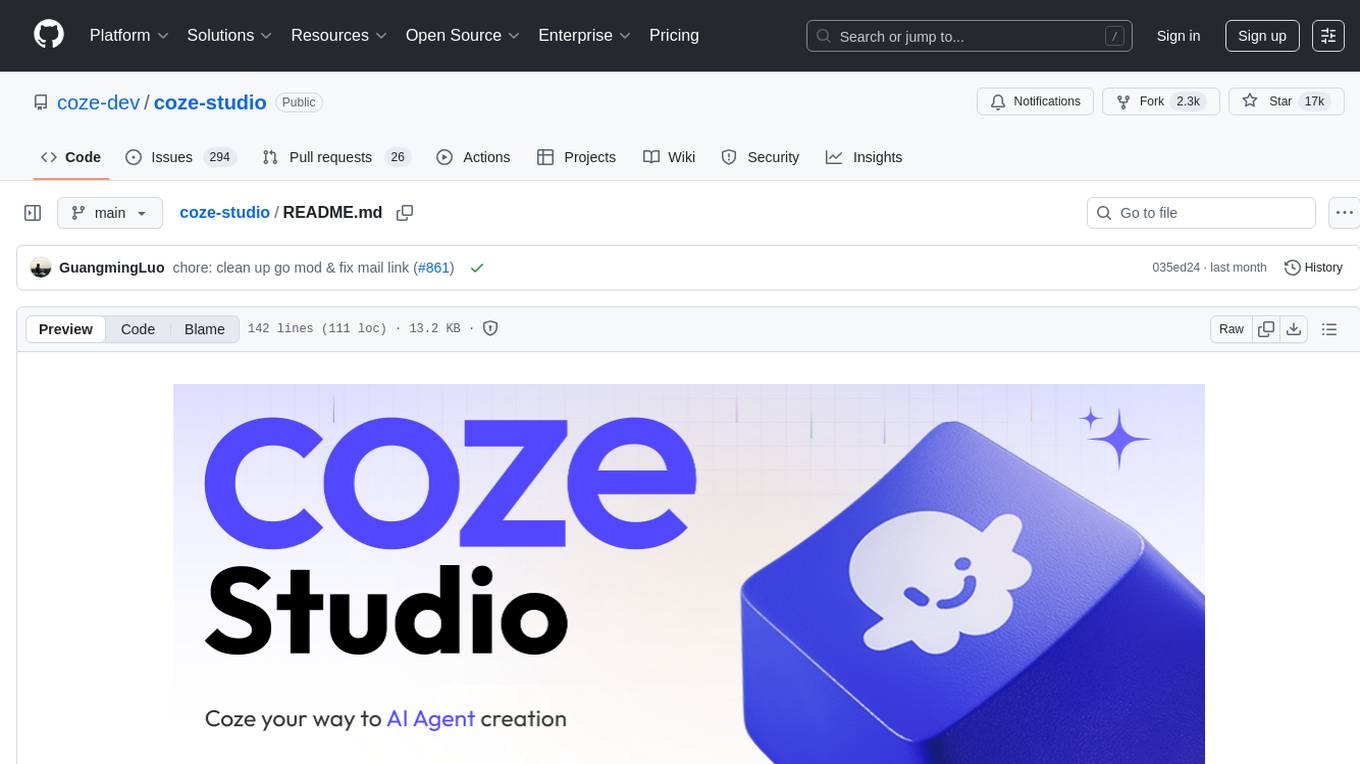
coze-studio
Coze Studio is an all-in-one AI agent development tool that offers the most convenient AI agent development environment, from development to deployment. It provides core technologies for AI agent development, complete app templates, and build frameworks. Coze Studio aims to simplify creating, debugging, and deploying AI agents through visual design and build tools, enabling powerful AI app development and customized business logic. The tool is developed using Golang for the backend, React + TypeScript for the frontend, and follows microservices architecture based on domain-driven design principles.
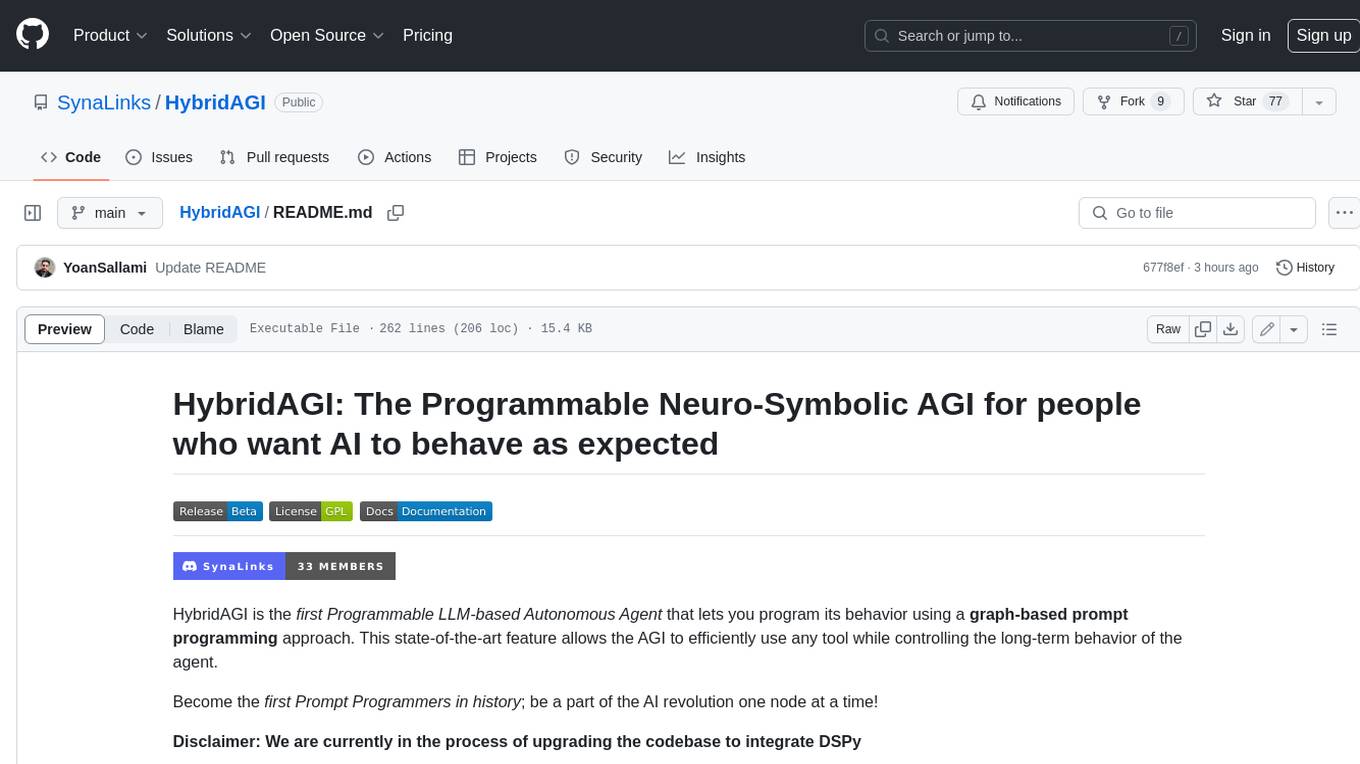
HybridAGI
HybridAGI is the first Programmable LLM-based Autonomous Agent that lets you program its behavior using a **graph-based prompt programming** approach. This state-of-the-art feature allows the AGI to efficiently use any tool while controlling the long-term behavior of the agent. Become the _first Prompt Programmers in history_ ; be a part of the AI revolution one node at a time! **Disclaimer: We are currently in the process of upgrading the codebase to integrate DSPy**
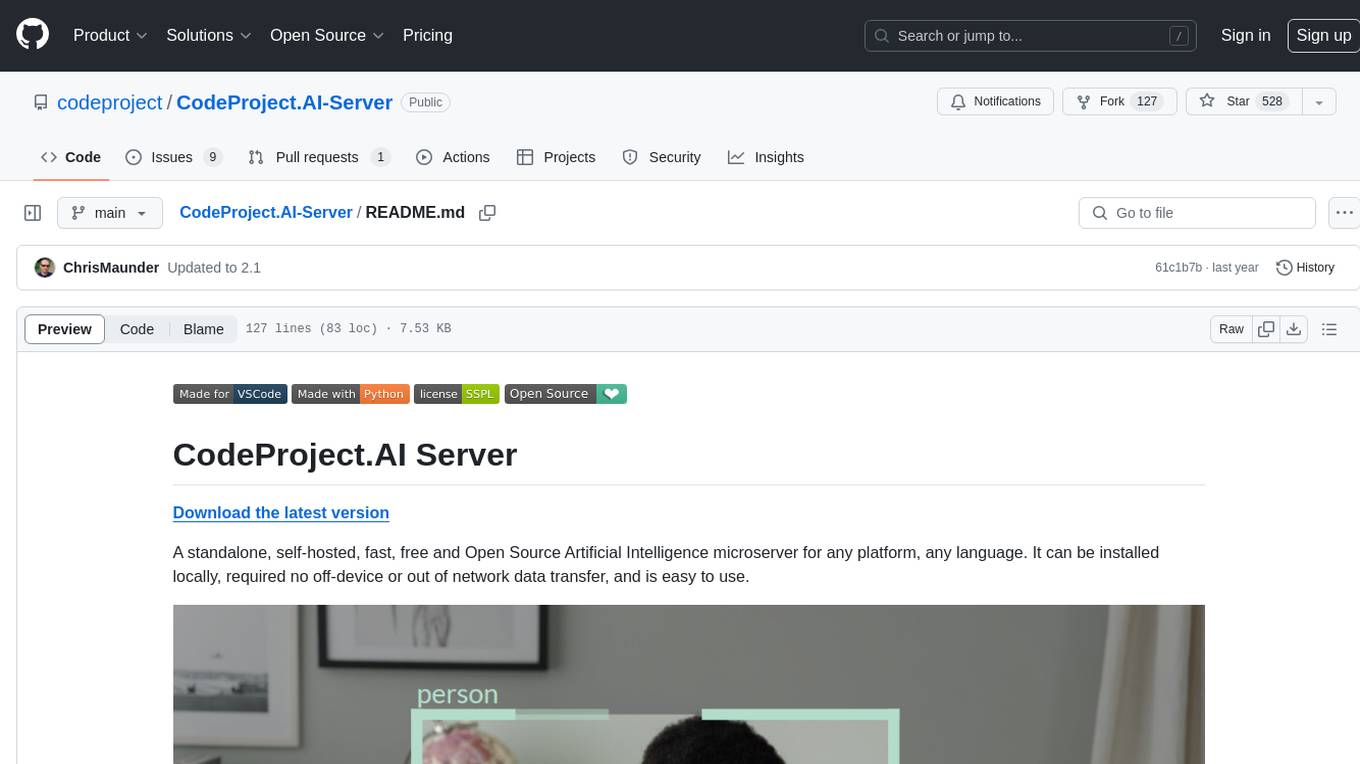
CodeProject.AI-Server
CodeProject.AI Server is a standalone, self-hosted, fast, free, and open-source Artificial Intelligence microserver designed for any platform and language. It can be installed locally without the need for off-device or out-of-network data transfer, providing an easy-to-use solution for developers interested in AI programming. The server includes a HTTP REST API server, backend analysis services, and the source code, enabling users to perform various AI tasks locally without relying on external services or cloud computing. Current capabilities include object detection, face detection, scene recognition, sentiment analysis, and more, with ongoing feature expansions planned. The project aims to promote AI development, simplify AI implementation, focus on core use-cases, and leverage the expertise of the developer community.
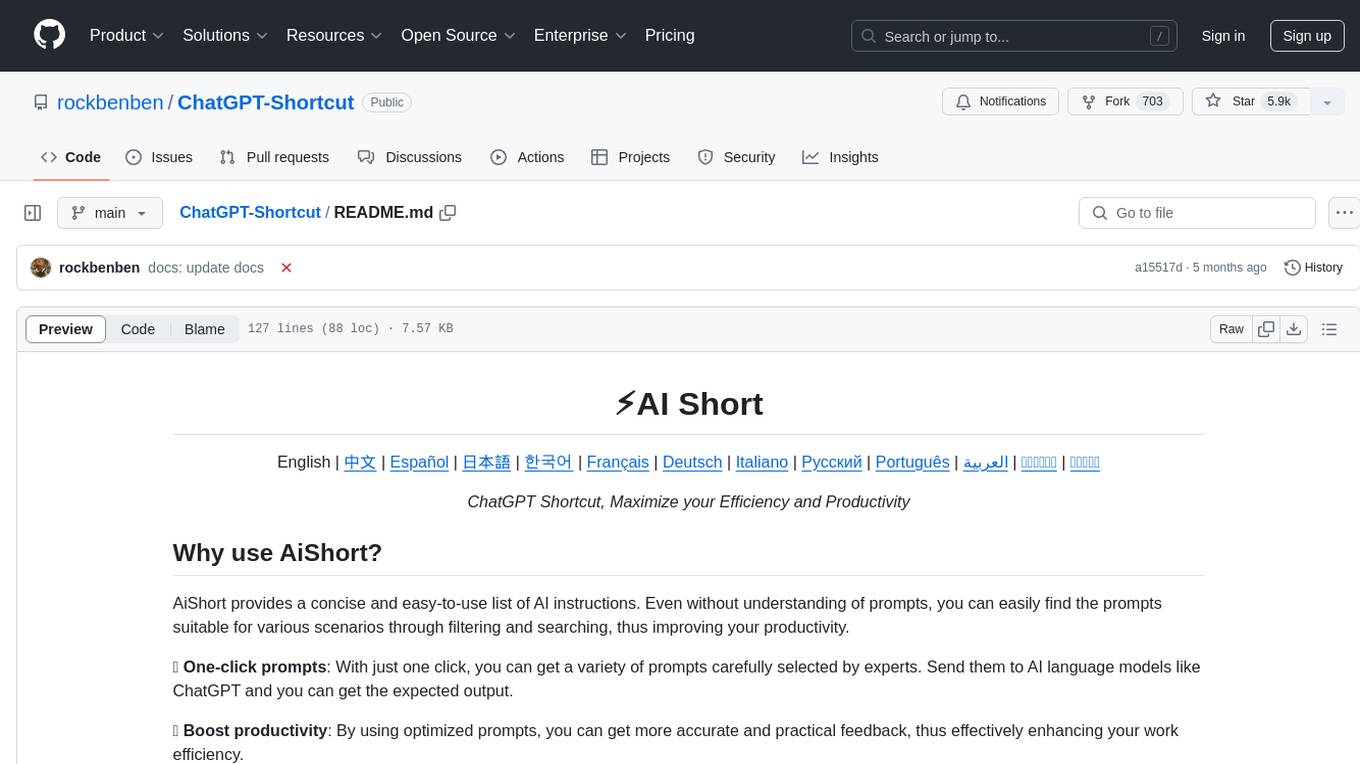
ChatGPT-Shortcut
ChatGPT Shortcut is an AI tool designed to maximize efficiency and productivity by providing a concise list of AI instructions. Users can easily find prompts suitable for various scenarios, boosting productivity and work efficiency. The tool offers one-click prompts, optimization for non-English languages, prompt saving and sharing, and a community voting system. It includes a browser extension compatible with Chrome, Edge, Firefox, and other Chromium-based browsers, as well as a Tampermonkey script for custom domain use. The tool is open-source, allowing users to modify the website's nomenclature, usage directives, and prompts for different languages.
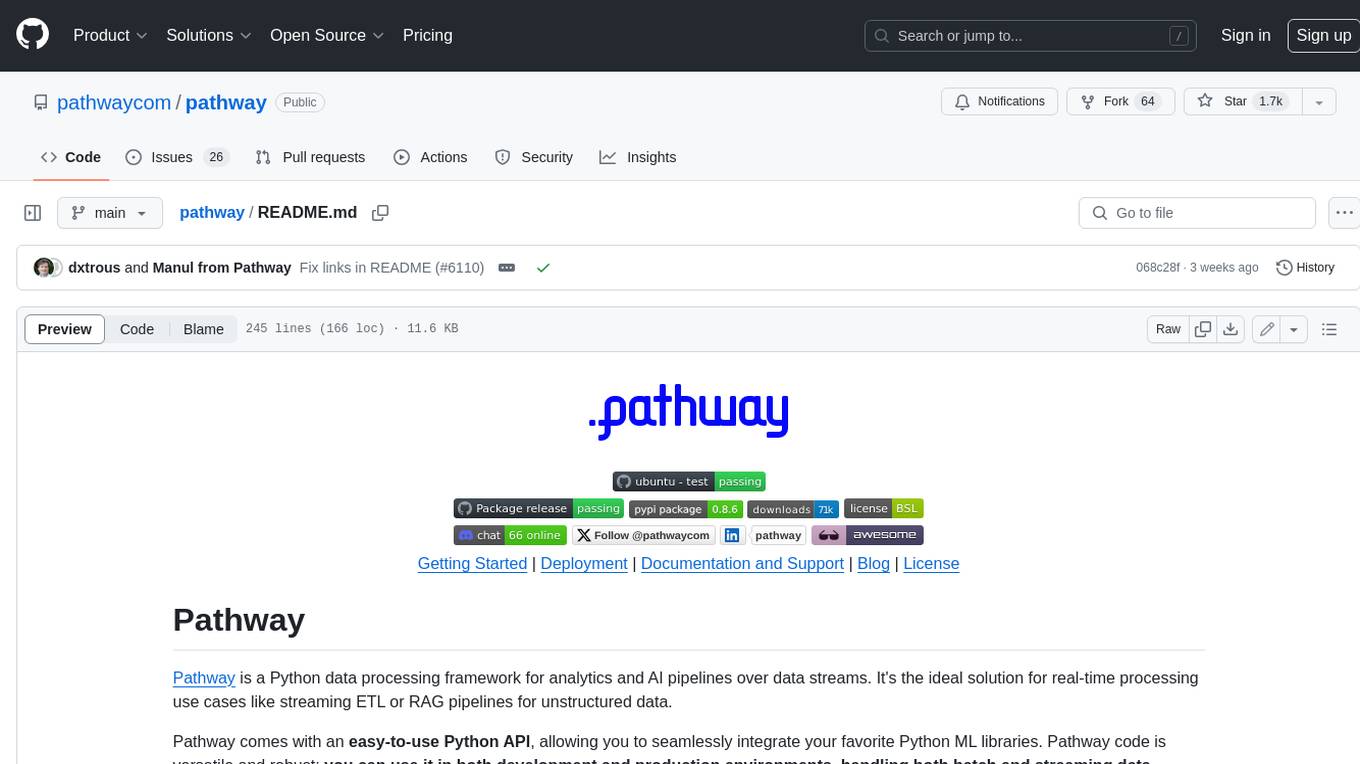
pathway
Pathway is a Python data processing framework for analytics and AI pipelines over data streams. It's the ideal solution for real-time processing use cases like streaming ETL or RAG pipelines for unstructured data. Pathway comes with an **easy-to-use Python API** , allowing you to seamlessly integrate your favorite Python ML libraries. Pathway code is versatile and robust: **you can use it in both development and production environments, handling both batch and streaming data effectively**. The same code can be used for local development, CI/CD tests, running batch jobs, handling stream replays, and processing data streams. Pathway is powered by a **scalable Rust engine** based on Differential Dataflow and performs incremental computation. Your Pathway code, despite being written in Python, is run by the Rust engine, enabling multithreading, multiprocessing, and distributed computations. All the pipeline is kept in memory and can be easily deployed with **Docker and Kubernetes**. You can install Pathway with pip: `pip install -U pathway` For any questions, you will find the community and team behind the project on Discord.
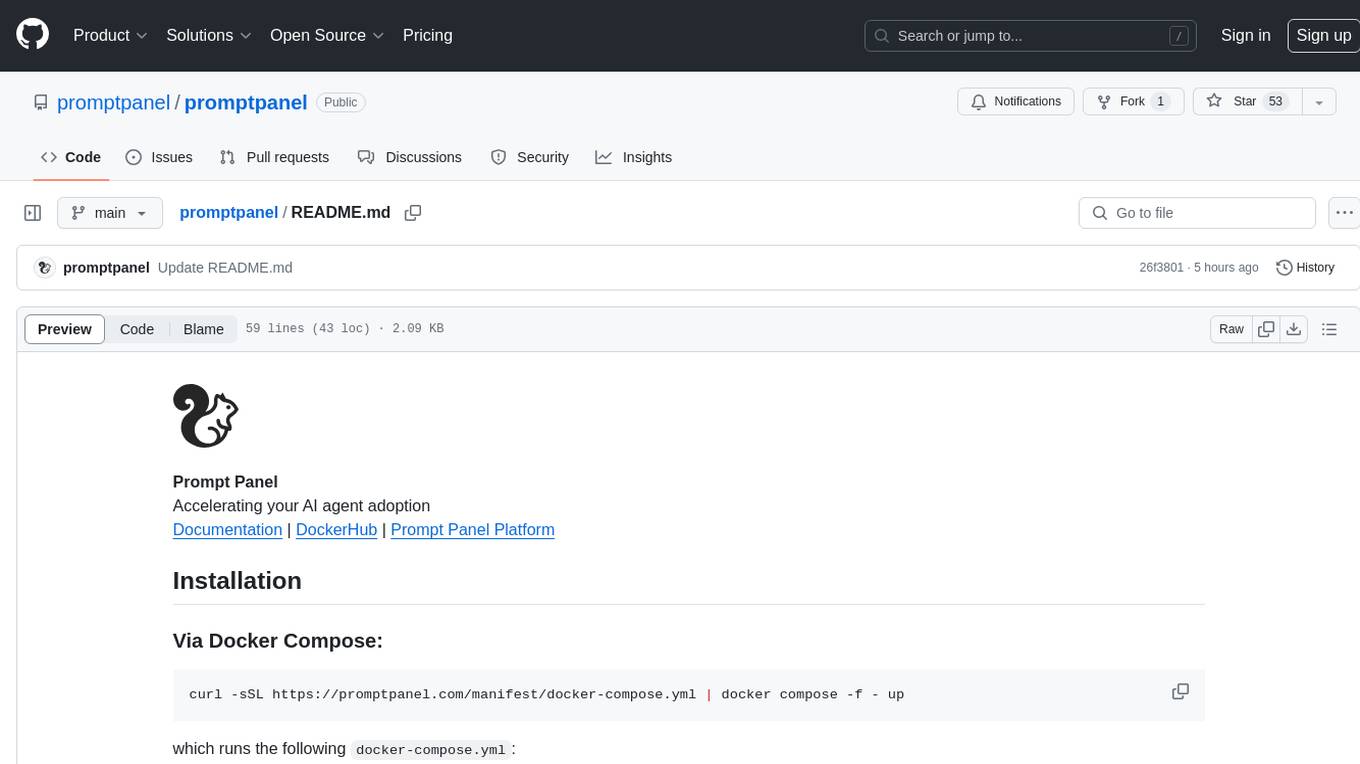
promptpanel
Prompt Panel is a tool designed to accelerate the adoption of AI agents by providing a platform where users can run large language models across any inference provider, create custom agent plugins, and use their own data safely. The tool allows users to break free from walled-gardens and have full control over their models, conversations, and logic. With Prompt Panel, users can pair their data with any language model, online or offline, and customize the system to meet their unique business needs without any restrictions.
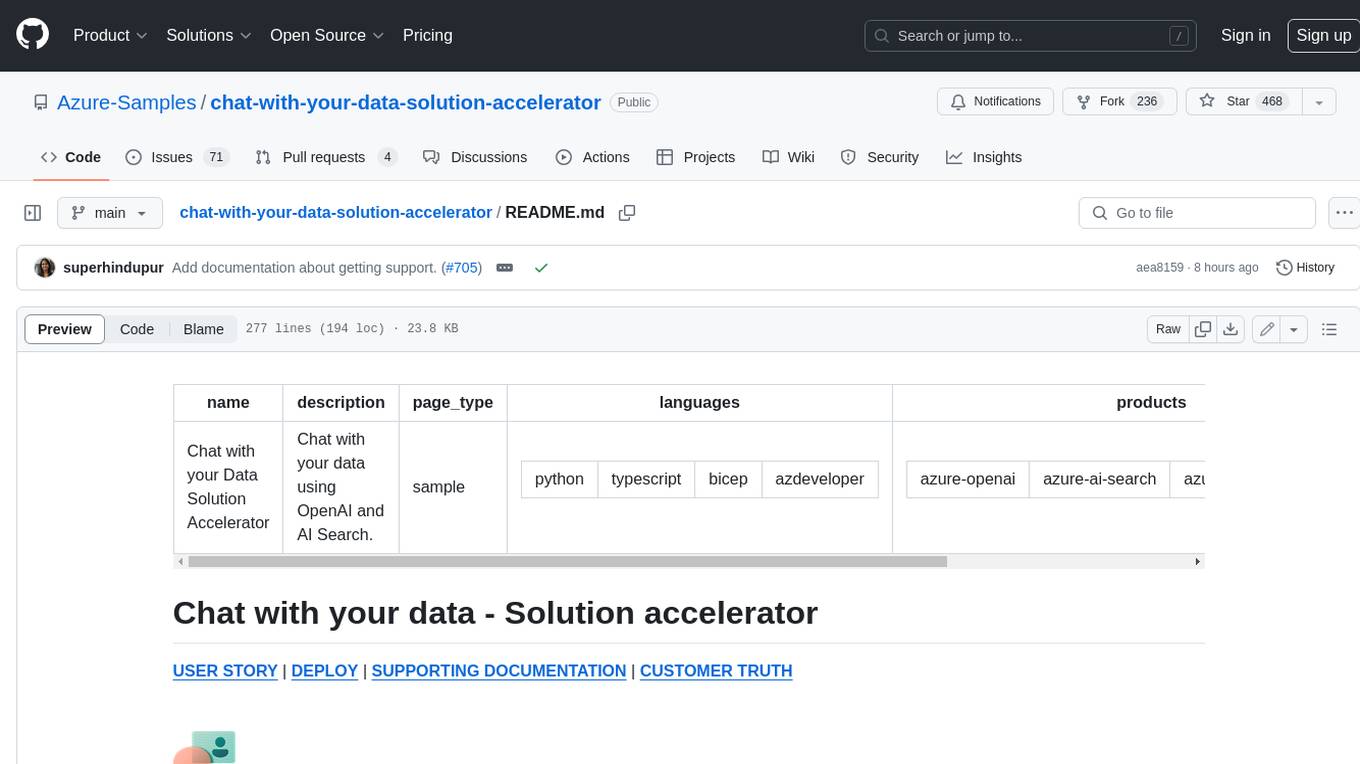
chat-with-your-data-solution-accelerator
Chat with your data using OpenAI and AI Search. This solution accelerator uses an Azure OpenAI GPT model and an Azure AI Search index generated from your data, which is integrated into a web application to provide a natural language interface, including speech-to-text functionality, for search queries. Users can drag and drop files, point to storage, and take care of technical setup to transform documents. There is a web app that users can create in their own subscription with security and authentication.
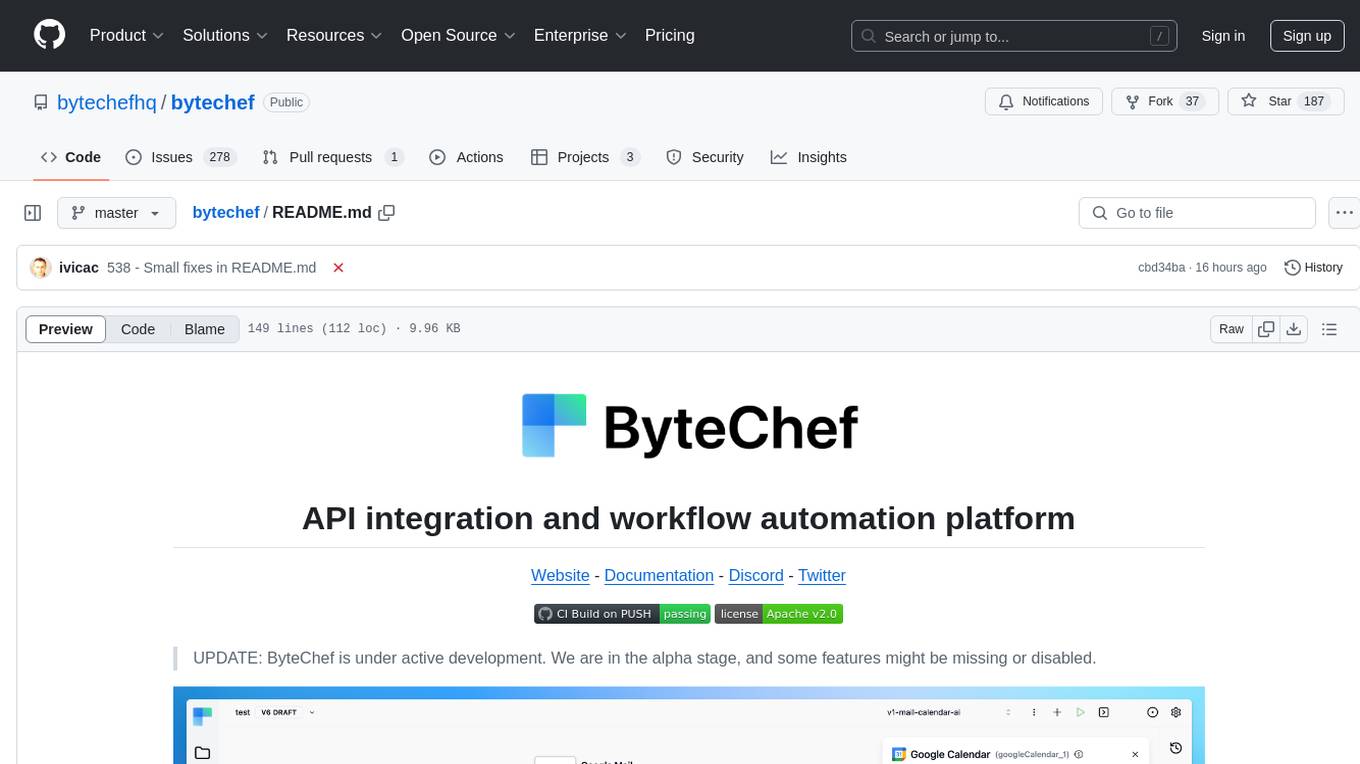
bytechef
ByteChef is an open-source, low-code, extendable API integration and workflow automation platform. It provides an intuitive UI Workflow Editor, event-driven & scheduled workflows, multiple flow controls, built-in code editor supporting Java, JavaScript, Python, and Ruby, rich component ecosystem, extendable with custom connectors, AI-ready with built-in AI components, developer-ready to expose workflows as APIs, version control friendly, self-hosted, scalable, and resilient. It allows users to build and visualize workflows, automate tasks across SaaS apps, internal APIs, and databases, and handle millions of workflows with high availability and fault tolerance.
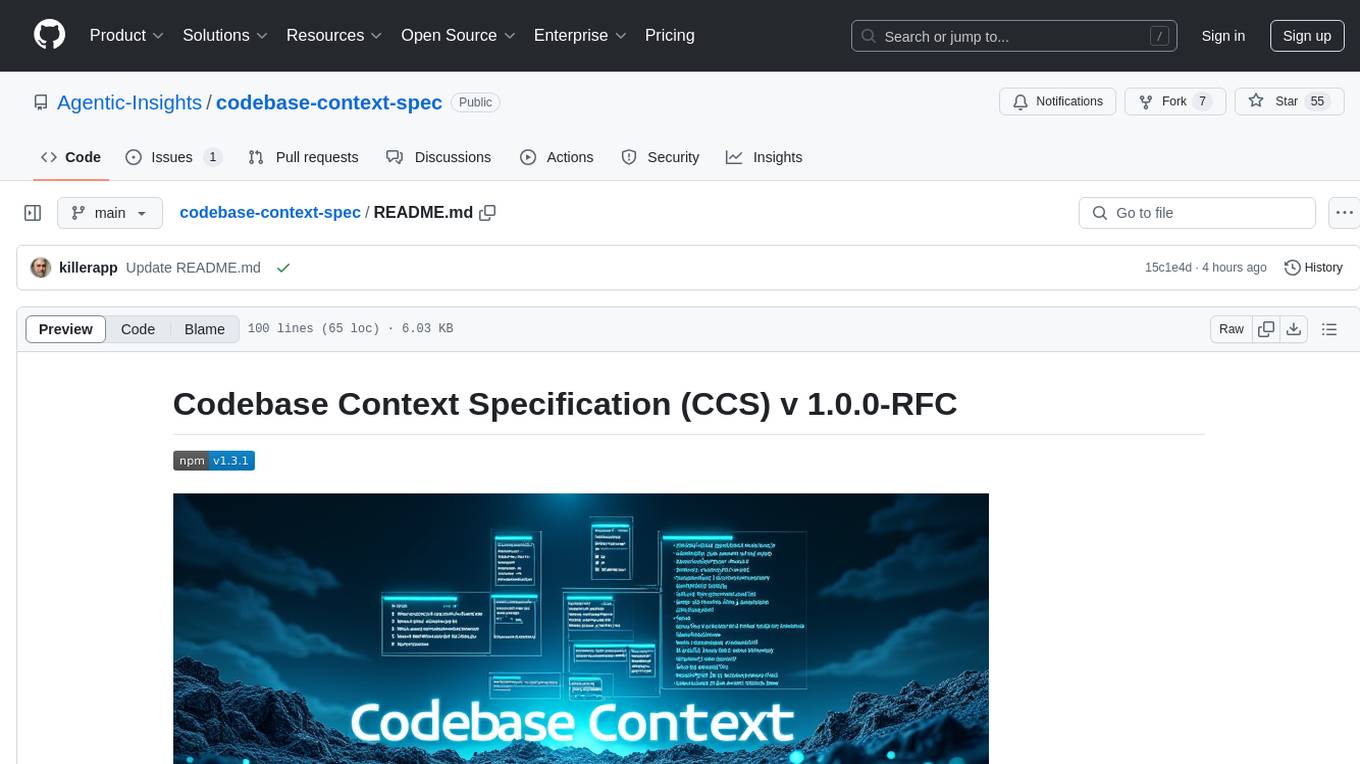
codebase-context-spec
The Codebase Context Specification (CCS) project aims to standardize embedding contextual information within codebases to enhance understanding for both AI and human developers. It introduces a convention similar to `.env` and `.editorconfig` files but focused on documenting code for both AI and humans. By providing structured contextual metadata, collaborative documentation guidelines, and standardized context files, developers can improve code comprehension, collaboration, and development efficiency. The project includes a linter for validating context files and provides guidelines for using the specification with AI assistants. Tooling recommendations suggest creating memory systems, IDE plugins, AI model integrations, and agents for context creation and utilization. Future directions include integration with existing documentation systems, dynamic context generation, and support for explicit context overriding.
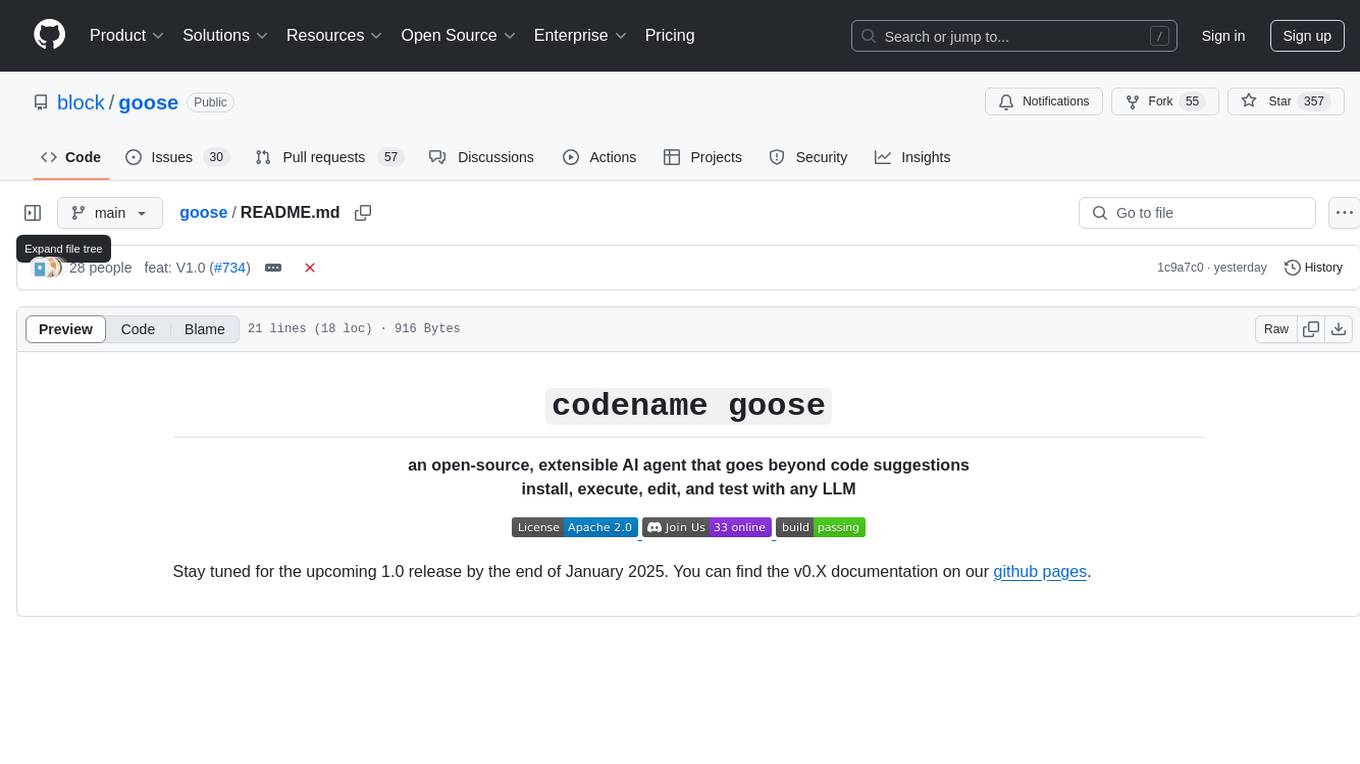
goose
Codename Goose is an open-source, extensible AI agent designed to provide functionalities beyond code suggestions. Users can install, execute, edit, and test with any LLM. The tool aims to enhance the coding experience by offering advanced features and capabilities. Stay updated for the upcoming 1.0 release scheduled by the end of January 2025. Explore the v0.X documentation available on the project's GitHub pages.
For similar tasks

generative_ai_with_langchain
Generative AI with LangChain is a code repository for building large language model (LLM) apps with Python, ChatGPT, and other LLMs. The repository provides code examples, instructions, and configurations for creating generative AI applications using the LangChain framework. It covers topics such as setting up the development environment, installing dependencies with Conda or Pip, using Docker for environment setup, and setting API keys securely. The repository also emphasizes stability, code updates, and user engagement through issue reporting and feedback. It aims to empower users to leverage generative AI technologies for tasks like building chatbots, question-answering systems, software development aids, and data analysis applications.
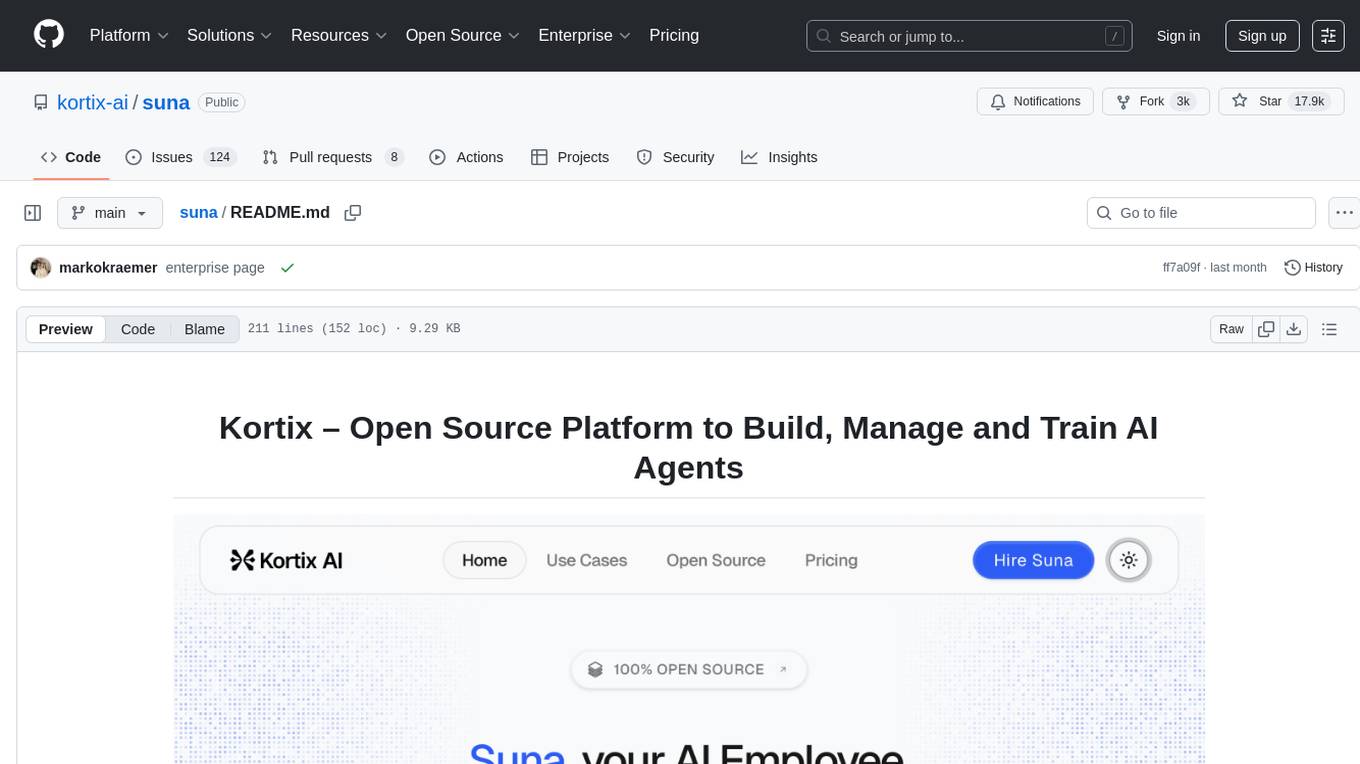
suna
Kortix is an open-source platform designed to build, manage, and train AI agents for various tasks. It allows users to create autonomous agents, from general-purpose assistants to specialized automation tools. The platform offers capabilities such as browser automation, file management, web intelligence, system operations, API integrations, and agent building tools. Users can create custom agents tailored to specific domains, workflows, or business needs, enabling tasks like research & analysis, browser automation, file & document management, data processing & analysis, and system administration.

agentcloud
AgentCloud is an open-source platform that enables companies to build and deploy private LLM chat apps, empowering teams to securely interact with their data. It comprises three main components: Agent Backend, Webapp, and Vector Proxy. To run this project locally, clone the repository, install Docker, and start the services. The project is licensed under the GNU Affero General Public License, version 3 only. Contributions and feedback are welcome from the community.

zep-python
Zep is an open-source platform for building and deploying large language model (LLM) applications. It provides a suite of tools and services that make it easy to integrate LLMs into your applications, including chat history memory, embedding, vector search, and data enrichment. Zep is designed to be scalable, reliable, and easy to use, making it a great choice for developers who want to build LLM-powered applications quickly and easily.
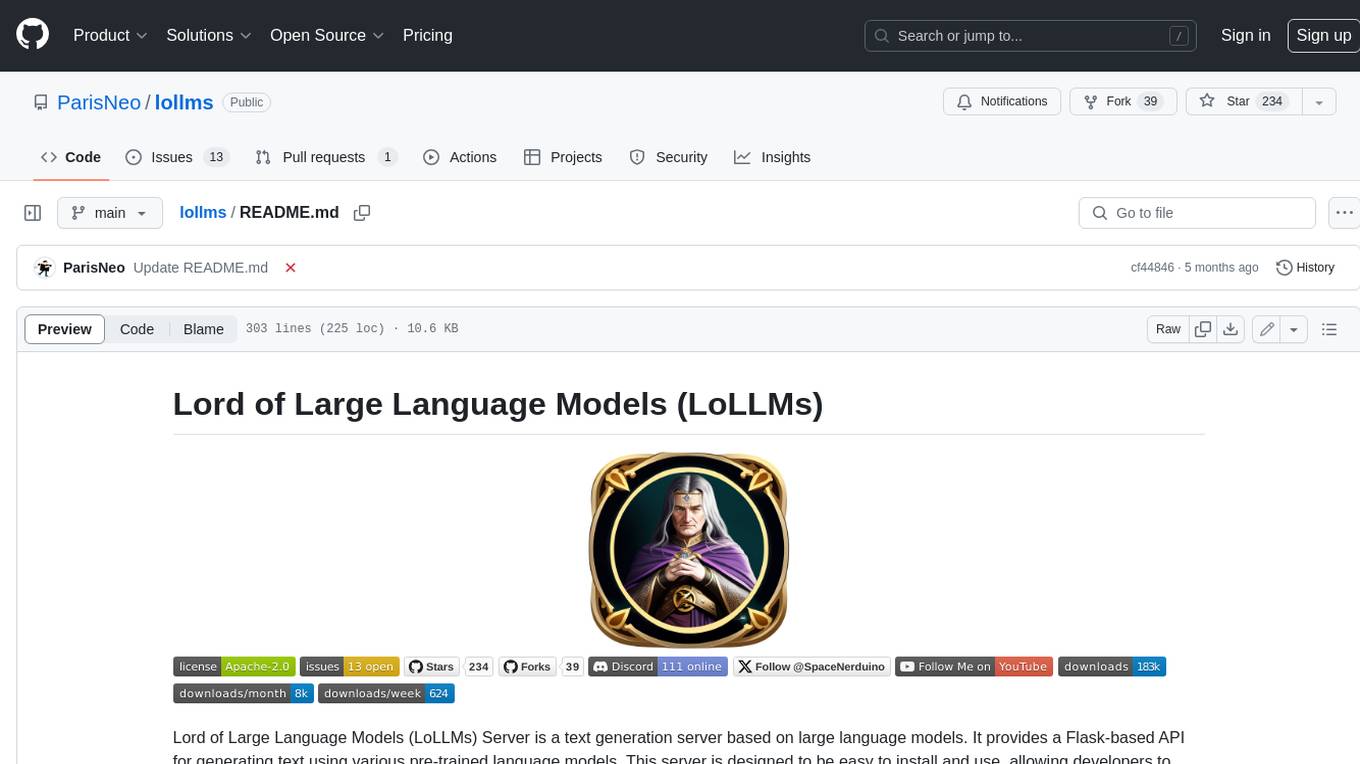
lollms
LoLLMs Server is a text generation server based on large language models. It provides a Flask-based API for generating text using various pre-trained language models. This server is designed to be easy to install and use, allowing developers to integrate powerful text generation capabilities into their applications.
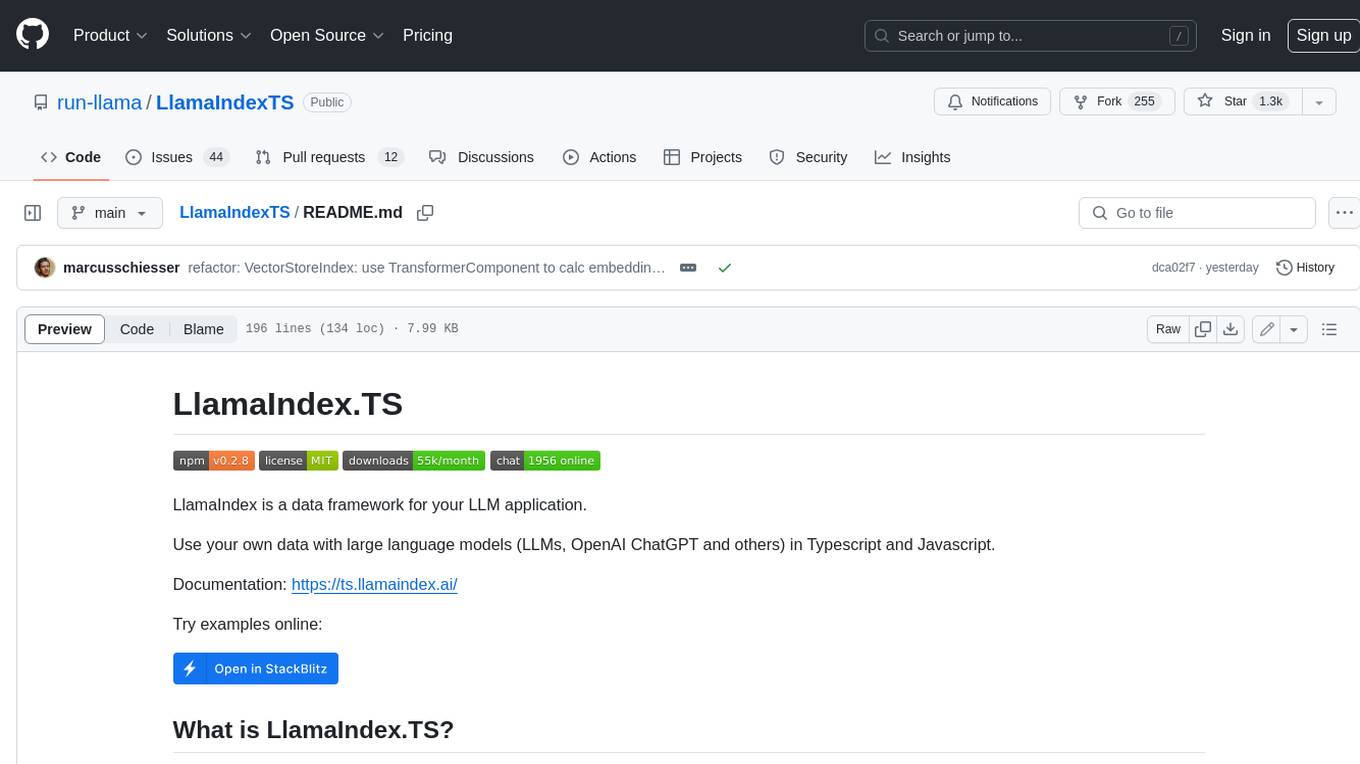
LlamaIndexTS
LlamaIndex.TS is a data framework for your LLM application. Use your own data with large language models (LLMs, OpenAI ChatGPT and others) in Typescript and Javascript.

semantic-kernel
Semantic Kernel is an SDK that integrates Large Language Models (LLMs) like OpenAI, Azure OpenAI, and Hugging Face with conventional programming languages like C#, Python, and Java. Semantic Kernel achieves this by allowing you to define plugins that can be chained together in just a few lines of code. What makes Semantic Kernel _special_ , however, is its ability to _automatically_ orchestrate plugins with AI. With Semantic Kernel planners, you can ask an LLM to generate a plan that achieves a user's unique goal. Afterwards, Semantic Kernel will execute the plan for the user.
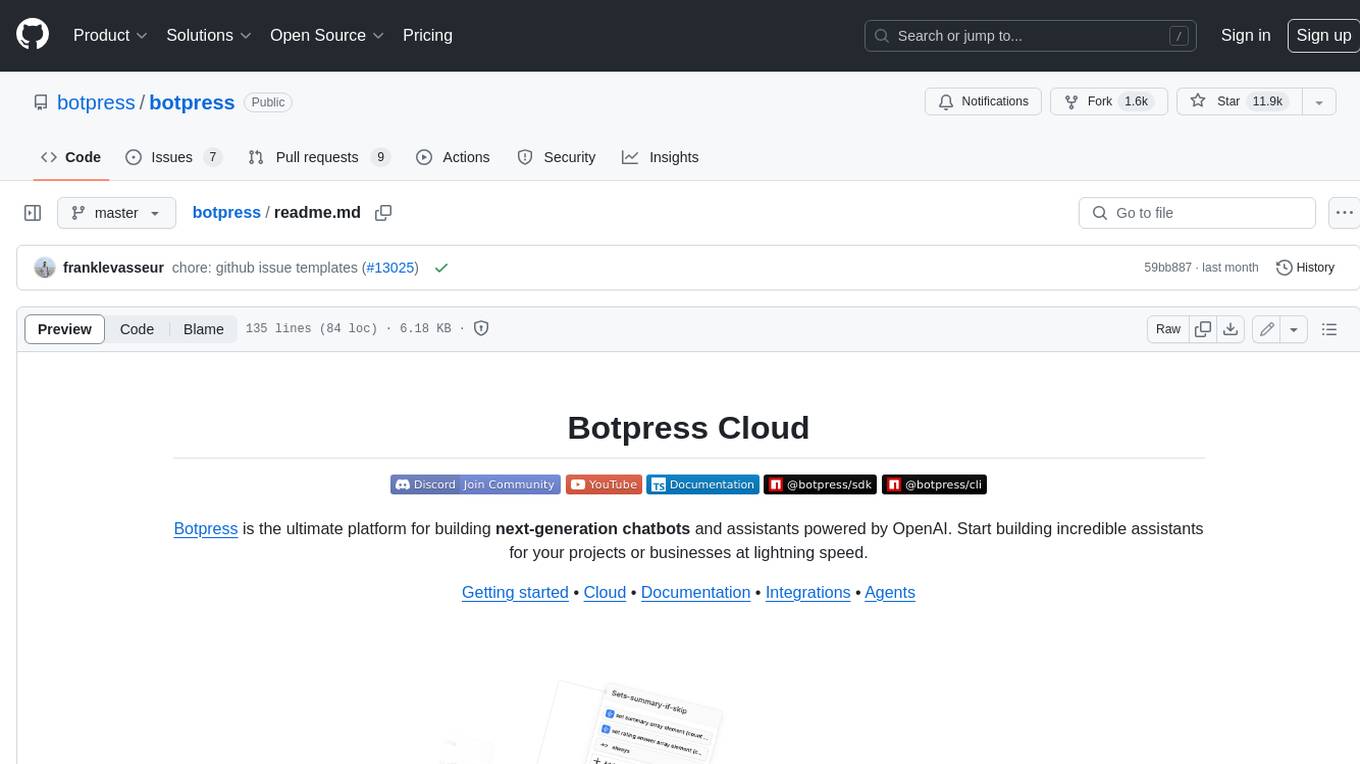
botpress
Botpress is a platform for building next-generation chatbots and assistants powered by OpenAI. It provides a range of tools and integrations to help developers quickly and easily create and deploy chatbots for various use cases.
For similar jobs

weave
Weave is a toolkit for developing Generative AI applications, built by Weights & Biases. With Weave, you can log and debug language model inputs, outputs, and traces; build rigorous, apples-to-apples evaluations for language model use cases; and organize all the information generated across the LLM workflow, from experimentation to evaluations to production. Weave aims to bring rigor, best-practices, and composability to the inherently experimental process of developing Generative AI software, without introducing cognitive overhead.

LLMStack
LLMStack is a no-code platform for building generative AI agents, workflows, and chatbots. It allows users to connect their own data, internal tools, and GPT-powered models without any coding experience. LLMStack can be deployed to the cloud or on-premise and can be accessed via HTTP API or triggered from Slack or Discord.

VisionCraft
The VisionCraft API is a free API for using over 100 different AI models. From images to sound.

kaito
Kaito is an operator that automates the AI/ML inference model deployment in a Kubernetes cluster. It manages large model files using container images, avoids tuning deployment parameters to fit GPU hardware by providing preset configurations, auto-provisions GPU nodes based on model requirements, and hosts large model images in the public Microsoft Container Registry (MCR) if the license allows. Using Kaito, the workflow of onboarding large AI inference models in Kubernetes is largely simplified.

PyRIT
PyRIT is an open access automation framework designed to empower security professionals and ML engineers to red team foundation models and their applications. It automates AI Red Teaming tasks to allow operators to focus on more complicated and time-consuming tasks and can also identify security harms such as misuse (e.g., malware generation, jailbreaking), and privacy harms (e.g., identity theft). The goal is to allow researchers to have a baseline of how well their model and entire inference pipeline is doing against different harm categories and to be able to compare that baseline to future iterations of their model. This allows them to have empirical data on how well their model is doing today, and detect any degradation of performance based on future improvements.

tabby
Tabby is a self-hosted AI coding assistant, offering an open-source and on-premises alternative to GitHub Copilot. It boasts several key features: * Self-contained, with no need for a DBMS or cloud service. * OpenAPI interface, easy to integrate with existing infrastructure (e.g Cloud IDE). * Supports consumer-grade GPUs.

spear
SPEAR (Simulator for Photorealistic Embodied AI Research) is a powerful tool for training embodied agents. It features 300 unique virtual indoor environments with 2,566 unique rooms and 17,234 unique objects that can be manipulated individually. Each environment is designed by a professional artist and features detailed geometry, photorealistic materials, and a unique floor plan and object layout. SPEAR is implemented as Unreal Engine assets and provides an OpenAI Gym interface for interacting with the environments via Python.

Magick
Magick is a groundbreaking visual AIDE (Artificial Intelligence Development Environment) for no-code data pipelines and multimodal agents. Magick can connect to other services and comes with nodes and templates well-suited for intelligent agents, chatbots, complex reasoning systems and realistic characters.